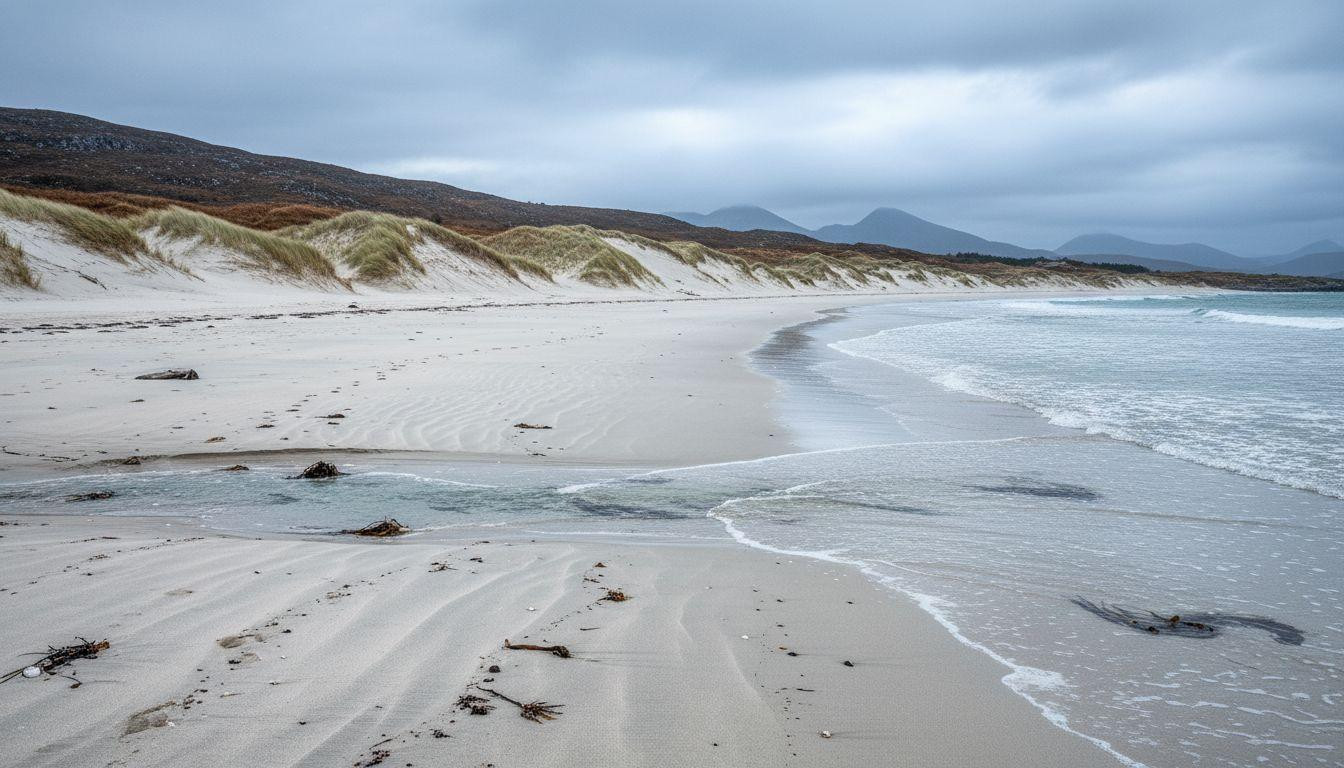Dawn breaks over Luskentyre Beach at 8:18 AM on November 15, 2025, as wind carries salt spray across white sand dunes. The water glows grey-blue beneath low Scottish clouds. Marketing calls this “Scotland’s Caribbean,” but that misleads entirely.
This isn’t tropical paradise misplaced 125 miles north of Edinburgh. This is Nordic coastal wilderness at its most dramatically authentic: ancient Lewisian gneiss, windswept moorland, 1.2-mile white sand beach where you’ll walk entirely alone.
While actual Caribbean beaches charge $360-750 nightly for resort crowds, Luskentyre delivers profound solitude for $75-190. The comparison isn’t fair to either destination.
Why Caribbean beaches set wrong expectations
Caribbean beaches promise 82°F water, palm trees, tropical cocktails, and sun-lounger convenience. That’s legitimate beauty but resort-commercial beauty.
Luskentyre’s “Caribbean waters” marketing misleads travelers expecting tropical conditions. November reality check: 50-53°F sea temperature, 46-50°F air temperature, 17-18 days of rain, persistent wind, 8 hours daylight, zero palm trees.
The landscape is treeless moorland, not tropical vegetation. The water color occasionally appears pale blue on rare clear days but comes from crushed shells and glacial minerals, not coral reefs.
This isn’t Caribbean paradise relocated. It’s something profoundly different: Scotland’s Outer Hebrides at their most austere and magnificent. Block Island offers similar North Atlantic solitude without misleading tropical comparisons.
Meet Luskentyre: Scotland’s most dramatic coastal wilderness
White sand stretches 1.2 miles along Harris’s west coast, backed by dunes rising toward windswept moorland. The sand itself creates pale coloring that catches November’s low-angle light.
The landscape nobody expects
Behind the beach, sparse vegetation displays muted browns and greys across treeless hills. The surrounding landscape sits on Lewisian gneiss, among Britain’s oldest rock formations shaped by ice age glaciation.
This is Nordic coastal beauty: restraint, drama, ancient geology. The water varies dramatically from grey-blue typically to occasionally clear pale turquoise on still days when light penetrates shallow areas.
But it’s always cold: 50-53°F in November. Swimming without wetsuit is uncomfortable for most. The visual appeal isn’t tropical vibrancy but rather windswept austerity.
The price reality: 56% less than Caribbean
Caribbean beach accommodation averages $360-750 nightly before meals or activities. Luskentyre’s Harris island offers guest houses $75-190 per night, self-catering cottages $500-1000 weekly.
Total daily budget: $100-190 for modest comfort, $190-310 for guest houses with restaurant dining. Compare to Caribbean’s $500-1000 daily including activities and meals.
Transportation costs: Edinburgh to Harris approximately 8-10 hours combined travel versus Caribbean’s 8-12 hours plus long-haul premium pricing. Similar value propositions exist throughout Europe for authentic alternatives.
What you’ll actually experience at Luskentyre
November is Luskentyre’s quietest month, deliberately not “best time” in conventional tourism terms. You’ll experience the beach alone or nearly alone among Harris’s 1,800 residents.
November’s radical solitude
No crowds, no facilities, no commercial infrastructure. This isolation isn’t limitation but the destination’s primary asset.
Walk 1.2 miles of beach without encountering another human. Watch November storms approach across Atlantic horizon. Experience daylight compressed into 8 hours with dramatic photography conditions: low-angle golden light, long shadows, atmospheric mist.
This isn’t relaxing beach vacation but wilderness immersion. Tasmania’s Tarkine Coast shares similar isolation and dramatic dune systems.
The Harris Tweed heritage experience
Harris produces the only legally protected tweed fabric, hand-woven from wool in individual island homes. Visit weavers’ workshops for authentic products ranging $37-375 depending on item.
The island maintains strong Gaelic cultural traditions with Scottish Gaelic spoken alongside English. Local cuisine emphasizes seafood and locally-raised lamb, prepared simply in Tarbert’s handful of small cafés.
This cultural continuity contrasts sharply with Caribbean resort culture. Here, you experience 5,000 years of continuous human habitation preserved authentically.
Planning your Harris island journey
From Edinburgh: fly to Inverness then drive 3.5 hours to Ullapool, or direct to Stornoway with 45-minute drive to Harris. Ullapool-Stornoway ferry takes 2.5 hours.
Essential preparation: waterproof jacket and trousers, warm layers, waterproof hiking boots, windproof outerwear. Standard summer beachwear is dangerously inadequate for November conditions.
Weather changes rapidly. Limited accommodation requires advance booking with potential 10-20% November discounts. Mobile phone coverage is unreliable, GPS navigation necessary. Traditional UK destinations like Dunster offer complementary medieval heritage experiences.
Your questions about Luskentyre Beach, Scotland answered
Is November really the best time to visit Luskentyre?
November offers complete solitude and dramatic weather but harsh conditions. Temperatures average 46-50°F with 17-18 days of rain. July-August provide warmer temperatures (55-59°F) with 4-5 hours daily sunshine and tourist crowds.
How does the water actually compare to Caribbean beaches?
Luskentyre’s water occasionally appears pale turquoise due to crushed shells and light conditions, but averages 50-53°F in November versus Caribbean’s 82°F year-round. The “Caribbean waters” marketing claim misleads about both temperature and color consistency.
What makes Harris Tweed authentic compared to other wool products?
Harris Tweed holds Protected Geographical Indication status, meaning only hand-woven tweed from Harris and Lewis islands can legally bear the name. Production methods remain unchanged for 200 years with individual homes still weaving fabric.
Luskentyre isn’t Scotland’s Caribbean but something far more valuable: Scotland’s most dramatic coastal wilderness, preserved in ancient geological time, where November wind carries 5,000 years of human history across white sand toward grey-blue Atlantic water. For travelers seeking profound solitude and Nordic coastal drama at genuine value, Luskentyre delivers exactly what Caribbean resorts cannot: untamed, uncommercialized, unforgettable wilderness.
